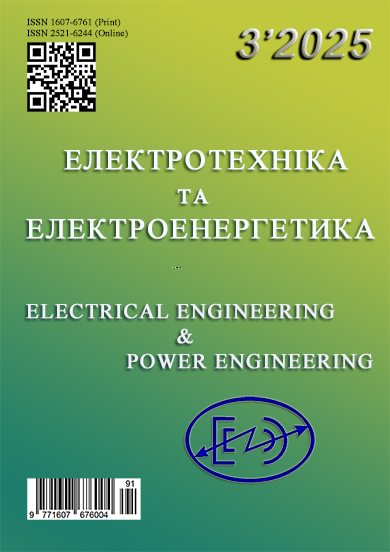Specific features of modeling distributed generation within electrical network structures using different software packages
DOI:
https://doi.org/10.15588/1607-6761-2025-3-4Keywords:
modeling, distributed generation, electrical networks, integration, voltage regulation, network stabilityAbstract
Purpose. The purpose of this study is to investigate the specific features of modeling distributed generation in the structure of electrical networks using different software packages. The work aims to identify the software that provides the necessary functionality, accuracy of calculations, ease of use, and license availability, while also considering the specific characteristics of Ukrainian electrical networks.
Methodology. Analysis of literary sources — applied to study the current state of the problem of distributed generation integration into electrical networks and to summarize both international and Ukrainian experience.
Comparative analysis — carried out to evaluate the functional capabilities of PowerFactory, Dakar Eleks, Matlab/Simulink, and Ansys according to the following criteria: modeling accuracy, computational performance, interface usability, availability of model libraries of distributed generation, the ability to model active and reactive power characteristics, voltage control characteristics, synchronization modes, and transient processes.
Findings. The key technical aspects of connecting distributed generation were identified, including the modeling of active and reactive power characteristics, voltage control characteristics, synchronization modes, transient processes, and automatic reconnection in accordance with the requirements of the Distribution System Code and the Transmission System Code. A comparative analysis of the functional capabilities of PowerFactory, Dakar Eleks, Matlab/Simulink, and Ansys was performed. International experience with the use of these software tools and the features of their adaptation to Ukrainian regulatory requirements were also analyzed.
Originality. A new approach is proposed for evaluating software packages for modeling the connection of distributed generation, which takes into account the specific features of Ukrainian electrical networks and the requirements of the Distribution System Code and the Transmission System Code.
Practical value. The results of this study can be applied in the process of selecting software for modeling the integration of distributed generation in Ukrainian electrical networks. The proposed approach makes it possible to reasonably determine optimal connection points, assess the influence of distributed generation on the operating conditions of the power system, and improve the efficiency of network development planning.
References
Distribution System Code. Resolution of the NEURC No. 310 dated 14.03.2018.
Transmission System Code. Resolution of the NEURC No. 309 dated 14.03.2018.
IEEE Standards Association. (2018). IEEE Std 1547-2018 — Standard for Interconnection and Interop-erability of Distributed Energy Resources with Asso-ciated Electric Power Systems Interfaces.
Liu, Z., et al. (2020). Resilient distribution system lev-eraging distributed generation and microgrids: A re-view. IET Energy Systems Integration. https://doi.org/10.1049/iet-esi.2019.0134
Brown, T., Hörsch, J., & Schlachtberger, D. (2017). PyPSA: Python for power system analysis. arXiv preprint, arXiv:1707.09913.
Mishra, S., Pohl, J., Laws, N., Cutler, D., Kwasnik, T., Becker, W., Zolan, A., Anderson, K., Olis, D., & Elgqvist, E. (2020). Computational framework for behind-the-meter DER techno-economic modeling and optimization — REopt Lite. arXiv preprint, arXiv:2008.05873.
Ackermann T., Andersson G., Söder L. Distributed generation: a definition. Electric Power Systems Re-search. 2001. Vol. 57. P. 195–204.
Hatziargyriou N., Asano H., Iravani R., Marnay C. Microgrids. IEEE Power and Energy Magazine. 2007. Vol. 5(4). P. 78–94.
Smith J., Lopes J.A.P., Hatziargyriou N. Stability issues in distribution networks with distributed generation. IEEE Transactions on Power Systems. 2022. Vol. 37(4). P. 2561–2572.
Lopes J.A.P., Moreira C., Madureira A. Defining con-trol strategies for microgrids islanded operation. IEEE Transactions on Power Systems. 2021. Vol. 26(2). P. 916–924.
Kovalchuk, O.M., Ivanenko, I.I., Petrov, P.P. Adap-tation of international approaches to distributed gen-eration integration under Ukrainian conditions. Bulle-tin of Energy and Electrical Engineering. 2022. No. 2. P. 40–47.
Cherniuk, A.M., Kyrysov, I.H., Chervyk, Yu.O. Pro-spects for integrating renewable energy sources into Ukraine's power grids. Energy and Electrification. 2021. No. 5. P. 24–31.
DIXI Group. Balancing Ukraine's power system: challenges and solutions. Analytical report. Kyiv, 2023.
DIgSILENT PowerFactory Documentation. DIg-SILENT GmbH. [Online resource]. Available at: https://www.digsilent.de
Dakar Eleks. Official website of the software package. [Online resource]. Available at: https://eleks.com.
Matlab/Simulink Documentation. MathWorks. [Online resource]. Available at: https://www.mathworks.com/products/simulink.html
Ansys Electronics Desktop Documentation. Ansys Inc. [Online resource]. Available at: https://www.ansys.com/products/electronics/ansys-electronics-desktop
Downloads
Published
How to Cite
Issue
Section
License
Copyright (c) 2025 D.V. Smirnov, D.O. Danylchenko

This work is licensed under a Creative Commons Attribution-ShareAlike 4.0 International License.
Creative Commons Licensing Notifications in the Copyright Notices
Authors who publish with this journal agree to the following terms:
Authors retain copyright and grant the journal right of first publication with the work simultaneously licensed under aCreative Commons Attribution License that allows others to share the work with an acknowledgement of the work's authorship and initial publication in this journal.
Authors are able to enter into separate, additional contractual arrangements for the non-exclusive distribution of the journal's published version of the work (e.g., post it to an institutional repository or publish it in a book), with an acknowledgement of its initial publication in this journal.
Authors are permitted and encouraged to post their work online (e.g., in institutional repositories or on their website) prior to and during the submission process, as it can lead to productive exchanges, as well as earlier and greater citation of published work.

